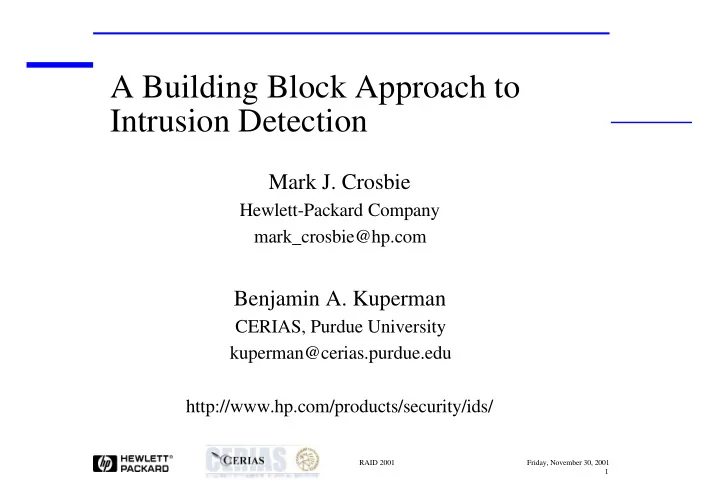

A Building Block Approach to Intrusion Detection Mark J. Crosbie Hewlett-Packard Company mark_crosbie@hp.com Benjamin A. Kuperman CERIAS, Purdue University kuperman@cerias.purdue.edu http://www.hp.com/products/security/ids/ RAID 2001 Friday, November 30, 2001 1
Who are we? • Mark Crosbie – Security Architect at Hewlett-Packard – Designed and implemented IDS/9000 • Benjamin Kuperman – PhD student at CERIAS, Purdue – Worked with HP on IDS/9000 – Designed and implemented detection templates RAID 2001 Friday, November 30, 2001 2
For more information... • Product is available for zero-cost for HP-UX 11.0 and 11i systems. • Download from http://software.hp.com • Part number is J5083AA • More information at http://www.hp.com/products/security/ids/ • Contact Mark Crosbie mark_crosbie@hp.com for further details. RAID 2001 Friday, November 30, 2001 3
What did we build? • Kernel level audit source designed to support Intrusion Detection. • An analysis engine that dynamically loads/unloads configurable detection template bytecode. • Detection templates – Detect the building blocks of intrusions. • Automated intrusion response mechanism. • GUI, manual, product support, etc etc... RAID 2001 Friday, November 30, 2001 4
RAID 2001 Friday, November 30, 2001 5
Why choose system call audit? • Kernel has the only reliable view of system state. • System calls do not have unintended side effects (compare to library audit). • Trustworthiness of data. • Ambiguity can be resolved at kernel level: – mapping inodes/file descriptors to pathnames. – symbolic/hard links, chroot. • Reliable capture of before and after state. RAID 2001 Friday, November 30, 2001 6
Requirement of audit system • Audit record must capture as much state as possible. – Save before/after state of objects for modification actions (e.g. chmod, chown). – Do not query system while processing record. • Resolve ambiguity in the kernel – symbolic links, hard links. – inodes mapped to pathnames. – chroot environments. • Data format must be machine parseable. • Data presented in timely and efficient manner. RAID 2001 Friday, November 30, 2001 7
What is a Building Block? Attacks Definition: An abstraction of attack Building Blocks activities undertaken to exploit a vulnerability. Vulnerabilities RAID 2001 Friday, November 30, 2001 8
Building Blocks Detected • Login/logout activities, including su. • Local and remote filesystem changes: – Directories and files. – Creation, deletion, attribute changes. – Changes to files owned by others. – Unusual Log file modifications. • Creation of setuid “ backdoors” . • Race condition (TOCTTOU) attacks. • Unexpected change in privileges. RAID 2001 Friday, November 30, 2001 9
Some sample alerts • Unexpected change in privilege levels with UID:100(GID:20) EUID:0(EGID:20) executing /usr/bin/ksh(1,42 246,"40000003") with arguments["/usr/bin/ksh", "-c", "foobar"] and system call kern_setuid as PID:19854 • UID:0 (EUID:0) Reference:/dev/emsagent_fifo currently kern_open:/dev/emsagent_fifo(8,1282,"40000003") was kern_mknod:/dev/emsagent_fifo(0,-1,"ffffffff") program running is /etc/opt/resmon/lbin/emsagent(1,1429,"40000003") with arguments ["/etc/opt/resmon/lbin/emsagent"] probable ATTACKER was UID:10 • User 0 opened for modification/truncation "/etc/opt/resmon/pipe/1652016795" executing /etc/opt/resmon/lbin/p_client(1,473,"40000004") with arguments ["/etc/opt/resmon/lbin/p_client"] as PID:2708 RAID 2001 Friday, November 30, 2001 10
Automated Response • Active response to a recent intrusion event. • Examples of responses: – Locking a user account. – Collecting additional system state information. • Recovering from configuration changes. – E.g. changes made under /etc • Recovering from Trojan Horses: Replacing files changed in /sbin or /usr/bin. • Recovering from a web server hack. – rsync web pages from remote source/CDROM. RAID 2001 Friday, November 30, 2001 11
Performance • Difficult to measure - why? – What is a typical system load? – How is the IDS to be configured? – Rate of “ intrusive” activity? Bursty? • How to measure performance impact? – System throughput, CPU time, response time. – IDS load, IDS throughput, IDS response time. • See paper for more details on our performance tests. RAID 2001 Friday, November 30, 2001 12
What IDS/9000 does not do. • Does not fix pre-existing vulnerabilities. • Does not prevent activities from occurring. • Does not detect changes made to local filesystems mounted on remote systems. – No file signature scanning. • Not currently a network IDS. RAID 2001 Friday, November 30, 2001 13
Conclusions • Possible to detect Building Blocks of intrusions. • By building the IDS and audit system together: – More context for making decisions. – Reliable detection. – Data is tailored to detection. • IDS can be used for more than security tasks: – monitor admins, misbehaving programs • Performance measurement is environmentally sensitive. RAID 2001 Friday, November 30, 2001 14
Recommend
More recommend